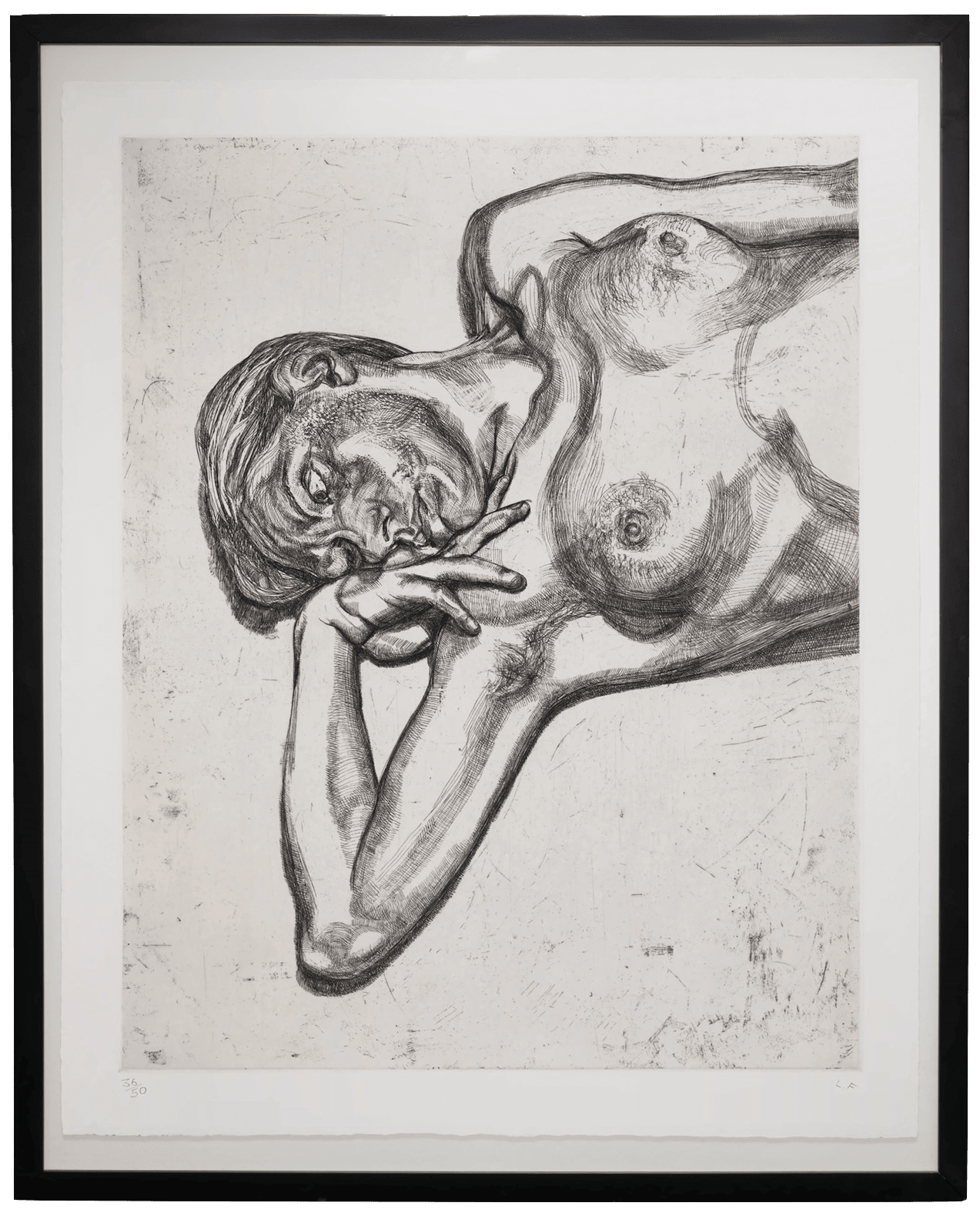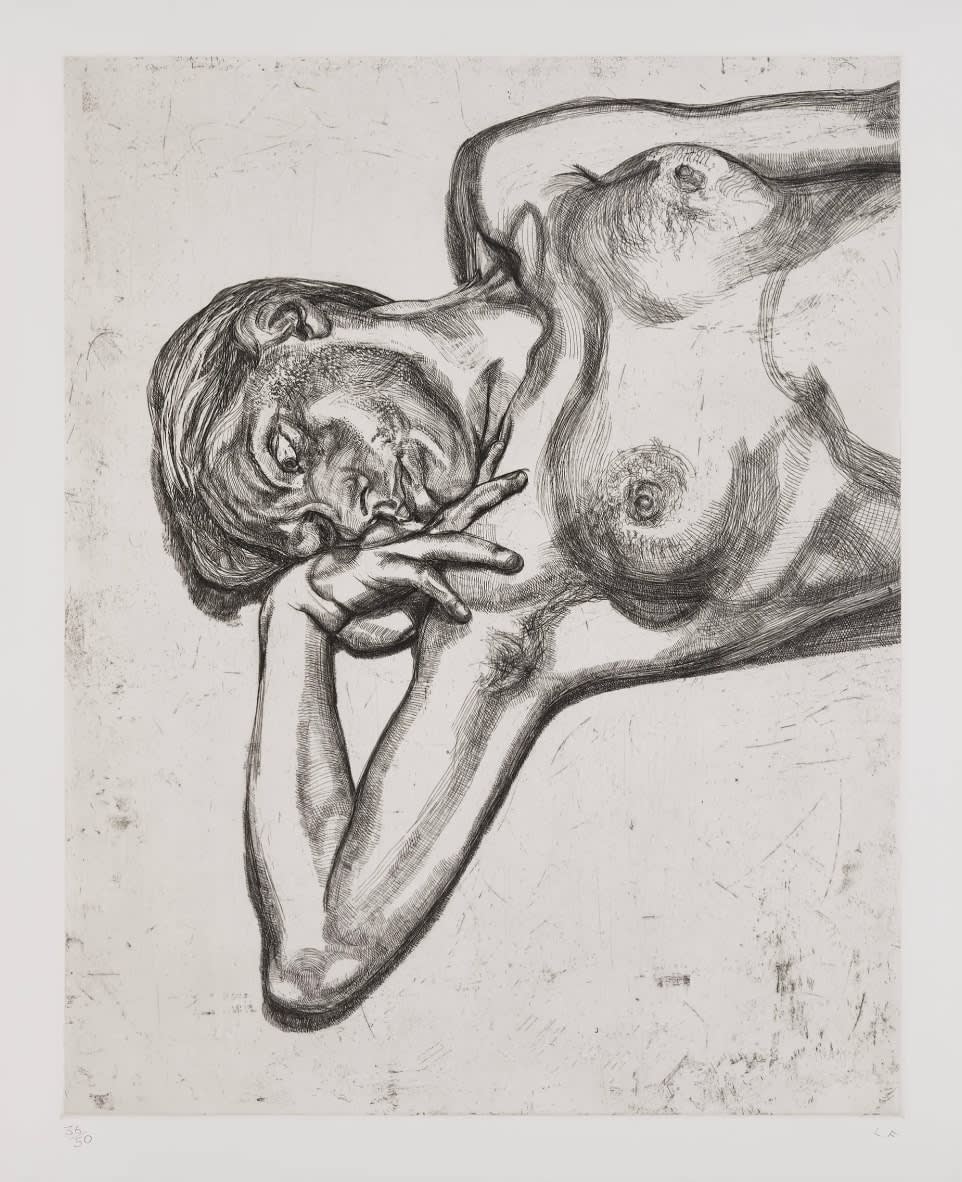Lucian Freud British, 1922-2011
Head and Shoulders of a Girl, 1990
Original etching on Somerset Satin White paper, framed
Inscribed with the artist's initials in pencil, lower right on recto
Inscribed with the artist's initials in pencil, lower right on recto
78 x 63 cm (framed: 87 x 72 cm)
© The Estate of Lucian Freud
Further images
Lucian Freud made this large-scale etching after his major painting of the same subject titled Lying by the Rags, 1988-89, which now resides in the Astrup Fearnley Collection, Oslo, Norway....
Lucian Freud made this large-scale etching after his major painting of the same subject titled Lying by the Rags, 1988-89, which now resides in the Astrup Fearnley Collection, Oslo, Norway. The sitter, artist Sophie de Stempel, is the subject of another major, related work, Standing by the Rags, 1989 – 90, in the collection of the Tate Gallery, London. In both paintings, the full-length model stands or lies before a large mound of cloth, her body, the fabric, and the floorboards all painted with equally piercing scrutiny. The oil paintings are quintessential examples of Freud’s ‘Naked Portraits’, a term he purposely uses to avoid any sense of an idealistic notion of a contrived human beauty.
As Starr Figura writes in her insightful catalogue, which accompanied a major retrospective of the artist’s etchings in 2007 at the Museum of Modern Art, New York:
‘Commonly viewed from an unusual vantage point, the angular limbs, foreshortened faces, and tortured body language rebuke the tradition of the ideal nude. Indeed, by deliberately referring to his depictions as ‘Naked Portraits’, Freud consciously distinguishes his works from venerable ‘nudes’ and emphasises the rawness that is central to his vision. The location is always Freud’s studio – a reference to the artist’s own world rather than any mythical or symbolic setting. “I am only interested in painting the actual person; in doing a painting of them, not in using them to some ulterior end of art”, he has stated. “For me, to use someone doing something not native to them would be wrong.” Ignoring whatever taboos regarding the body that may persist today, Freud means for his works to “astonish, disturb, seduce, convince.” Their strangeness comes, as Robert Hughes has written, ‘in large part from their making: they bypass decorum while fiercely preserving respect’.
When creating this etching Freud focused in, removing the padding of the cloths and the surface of the floorboards to construct a powerful composition, suspending the upper torso, head and shoulders of the model. Unlike the printmaking method of many other artists, Freud’s etchings are neither preparatory works for canvases nor are they merely reproductions of existing images. Instead, as Figura points out, ‘...etching is a medium that parallels painting for Freud, an extension of the habit of revisiting sitters that he has always enjoyed in painting. But shifting his means from painterly to linear involves an adjustment not just in manner of execution, but also in conception and perception, a refreshing shift that, he has said, forces him to concentrate more on form than on surface’.
As Starr Figura writes in her insightful catalogue, which accompanied a major retrospective of the artist’s etchings in 2007 at the Museum of Modern Art, New York:
‘Commonly viewed from an unusual vantage point, the angular limbs, foreshortened faces, and tortured body language rebuke the tradition of the ideal nude. Indeed, by deliberately referring to his depictions as ‘Naked Portraits’, Freud consciously distinguishes his works from venerable ‘nudes’ and emphasises the rawness that is central to his vision. The location is always Freud’s studio – a reference to the artist’s own world rather than any mythical or symbolic setting. “I am only interested in painting the actual person; in doing a painting of them, not in using them to some ulterior end of art”, he has stated. “For me, to use someone doing something not native to them would be wrong.” Ignoring whatever taboos regarding the body that may persist today, Freud means for his works to “astonish, disturb, seduce, convince.” Their strangeness comes, as Robert Hughes has written, ‘in large part from their making: they bypass decorum while fiercely preserving respect’.
When creating this etching Freud focused in, removing the padding of the cloths and the surface of the floorboards to construct a powerful composition, suspending the upper torso, head and shoulders of the model. Unlike the printmaking method of many other artists, Freud’s etchings are neither preparatory works for canvases nor are they merely reproductions of existing images. Instead, as Figura points out, ‘...etching is a medium that parallels painting for Freud, an extension of the habit of revisiting sitters that he has always enjoyed in painting. But shifting his means from painterly to linear involves an adjustment not just in manner of execution, but also in conception and perception, a refreshing shift that, he has said, forces him to concentrate more on form than on surface’.
展覽
Examples of this work are held in several important collections; Tate Gallery, London; Metropolitan Museum of Art, New York; National Gallery of Art, Washington; Milwaukee Art Museum; MoMA, New York
Art Gallery of Western Australia, Perth, 1 February – 14 March 1993, cat. 66
Lucian Freud ‘Etchings 1946–2004’, Scottish National Gallery, Edinburgh, 2 April – 13 June 2004, and touring to; Abbot Hall Art Gallery, Kendal; The Fitzwilliam Museum, Cambridge; Waterhall Gallery, Birmingham Museum and Art Gallery, Birmingham
Lucian Freud, The Painter’s Etchings, Museum of Modern Art, New York, 16 December 2007 – 10 March 2008, cat.52 (another example exhib.)








